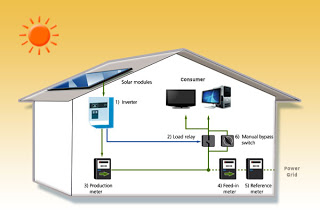Green Energy

- Sharp Solar Small Home System
Sharp's Solar Small Home System (SHS) is a complete stand-alone solar generation system. With the Sharp solar panel and Sharp Power Control System, the system is perfect for powering lightings, fans, radios, laptops, battery chargers and small devices. Each...
- Hybrid Solar System For Mini-grid
UAGES design and install solar and diesel hybrid systems in remote sites. Energy is mainly produced by solar panels, but a generator (5) is used as a back-up in case of bad weather, or over-consumption. Solar panels (1) generate electricity converted...
- Inverter For Solar Panels
Inverter is a power converter which converts Direct Current (DC) into Alternating Current (AC). As most of modern appliances operate on 120 volts AC, an inverter plays a key role for your solar power system. It can convert the low voltage DC to the 120...
- Solar Charge Controller
Solar charge controller is a device which regulates voltage and/or current to protect batteries from overcharging in the solar photovoltaic system. It has been observed that most solar panels of 12 volts have output voltage of 16 to 20 volts approximately....
- How Do I Calculate The Solar Pv Requirement For My House?
The reduced cost of solar photo-voltaic panel has created interest in households to opt for a solar panel on their roof top we have been getting various inquiries for roof top system sizing. Typically a house requires an average load of 2KW and 8 hours...
Green Energy
Roof Top System- Its Components
A Solar System generally comprises of the following elements: Solar Panel, a Charge Controller, a Power Inverter, a Monitor and Electrical Distribution System. As seen with each other technologies each component has different manufacturers , quality, features and price.
Solar Panel: A Solar Panel consists of silicon crystals which converts the rays on the sun into electricity. They supply electricity, required for charging batteries and running the appliances either directly or through power inverter. A combination of panels is used to produce the electricity which is more than the required and excess of energy is stored in battery for nighttime or cloudy days. They are available in different sizes, voltages and amperages. They can be connected be in series, parallel or both depending on design requirements of the system.
Charge Controller: It is a vital component and functions like the brain of system. It monitors the electricity produced by solar panels and then regulates the electricity to charge the batteries and prevent them from over-charging. It helps to increase battery life and performance. Different technologies are available for selection including Pulse Width Modulation (PWM) and Maximum Power Point Tracking (MPPT) charge controllers.
Batteries: They are required to store excess power generated from solar panels for later use. Without battery, power would only be available when the sun is shinning. The batteries are available in different voltages and varying amp-hour ratings depending on system requirements.
Inverter: It converts the DC Volts produced by solar panels into AC volts. The inverters can be used to charge batteries by connecting it to the backup generator or an AC electrical source. It is important to choose the right inverter for the demand and power requirements of the system so that the components can function properly.
Monitor: It is used to monitor the condition of the battery, the power generated by solar panels and consumption of power by the users. The monitors available in the market will provide you with information for protection of batteries, help’s to locate the source of the system problems where they occur and allows to reduce generator use , by knowing when to shut it down.
Generator: Gas powered generator is a good investment to keep the batteries charged during extended period of rainy/cloudy days. It can also provide temporary power when there is high demand for power. It is a handy tool to have when sunlight is not available.
On Grid: When to system is connected to local utility.
Off Grid: It is a system where solar powered structure would not be connected to external electrical device.
Grid Tie: It means that you can use solar energy when it is available and when that source is not available, have the system automatically switch to on-grid electricity from the power company.
- Sharp Solar Small Home System
Sharp's Solar Small Home System (SHS) is a complete stand-alone solar generation system. With the Sharp solar panel and Sharp Power Control System, the system is perfect for powering lightings, fans, radios, laptops, battery chargers and small devices. Each...
- Hybrid Solar System For Mini-grid
UAGES design and install solar and diesel hybrid systems in remote sites. Energy is mainly produced by solar panels, but a generator (5) is used as a back-up in case of bad weather, or over-consumption. Solar panels (1) generate electricity converted...
- Inverter For Solar Panels
Inverter is a power converter which converts Direct Current (DC) into Alternating Current (AC). As most of modern appliances operate on 120 volts AC, an inverter plays a key role for your solar power system. It can convert the low voltage DC to the 120...
- Solar Charge Controller
Solar charge controller is a device which regulates voltage and/or current to protect batteries from overcharging in the solar photovoltaic system. It has been observed that most solar panels of 12 volts have output voltage of 16 to 20 volts approximately....
- How Do I Calculate The Solar Pv Requirement For My House?
The reduced cost of solar photo-voltaic panel has created interest in households to opt for a solar panel on their roof top we have been getting various inquiries for roof top system sizing. Typically a house requires an average load of 2KW and 8 hours...
